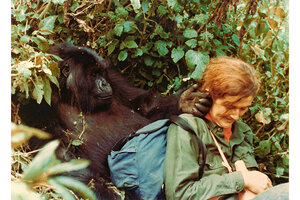Dian Fossey: What was her biggest discovery?
Google's homepage Thursday celebrates the 82 birthday of Dian Fossey, the American zoologist who drastically changed scientific and public perceptions of gorillas.

A photo showing Dian Fossey with a mountain gorilla.Google Doodle today celebrates the 82nd birthday of the late American zoologist. Fossey was killed in her cabin in Karisoke in Rwanda.
The Dian Fossey Gorilla Fund
Thanks to the work of Dian Fossey, we now know that the King Kong in real life is very different from the one in reel life.
Dr. Fossey, who spent 14 years studying mountain gorillas in the jungles that line the hills of the Virunga Volcanoes, a region shared by Rwanda, Uganda and Congo, is widely credited with changing the scientific as well as the public image of gorillas, says Tara Stoinski, chief scientific officer at The Dian Fossey Gorilla Fund International.
Fossey revealed, for instance, that mountain gorillas have families. Like humans, the mother gorilla shares a strong relationship with the offspring, and they mourn like us, says Dr. Stoinski.
Male and female gorillas within a group share a strong bond. "If the male member of a group dies, then females leave the group," Stoinski says.
Most of the day, they travel in search of food – these gentle giants are largely vegetarian – whereas at night they rest in their "night nests," which are built using branches and leaves, says Erika Archibald, the Fund's communications director.
Fossey also studied methods used by gorillas to communicate. For example, thumping of chest is a symbol of power and strength, and can be used in confrontation, Dr. Archibald adds.
For a long time, very little was known about mountain gorillas, who live at altitudes between about 7,000 and 14,000 feet. Most visitors to their habitats might only only see a glimpse of their fur or their hand, says Ian Redmond, primatologist and chairman of the international conservation group Ape Alliance.
"But [Fossey] was successful in winning the trust of the gorillas; not just as an observer but an honorary member of the family," says Dr. Redmond, who also worked with Fossey.
Fossey's subjects were comfortable even with a human observing them, he says. Unlike previous scientists who were viewed by the animals with suspicion and fear, Fossey witnessed these gorillas up close. She was a welcome guest in their family and eventually she became one of their family members, adds Redmond.
Her research was pivotal in opening up a better understanding of human beings by noticing our close relatives, say experts.
"We share common ancestors with them," Redmond says. "Gorillas, too, are like us in a lot of ways."
Many human behaviors such as, playing and tickling, exhibited by children in a playground are in fact shared by gorillas, he adds. Redmond describes Fossey as a "complicated woman" with a temper. "But in some ways she was simple and straight," he says.
After the death of Digit, an adult male gorilla whom Fossey watched and studied for 10 years, she founded the Digit Fund to raise money for the conservation of gorillas.
Digit was killed by poachers. "In fact, I found his body," says Redmond. "It was horrific. Dian watched him for 10 years. His hands were cut off. I considered him a friend but for Dian probably Digit was much more."
For Fossey, it was a personal loss. She channeled her emotion into action, says Redmond. She began campaigning against gorilla poaching.
"In the intervening years the conservation work she instigated and others followed, has helped in the conservation of mountain gorillas," he says. "We have Dian to thank for it."
In 1985, Fossey was killed in her cabin in Karisoke in Rwanda. In 1992, the Digit Fund was renamed in her honor. As a result of Fossey's conservation efforts, mountain gorillas are the only apes whose population is increasing, Redmond says.
There are now 480 mountain gorillas in the Virunga area. Their presence is also boosting the tourism industry and providing jobs to thousands in three of the poorest countries in the world – Democratic Republic of Congo, Rwanda and Uganda, Redmond says.
From a scientific standpoint, studying these creatures can also help scientists gain insights about human biology, Dr. Archibald says.
While every great ape species, including humans, is unique, each species is still an exponent of the big traits of the family, says Alex Kacelnik, professor at the department of zoology at Oxford University. Understanding nonhuman apes helps us form a big picture about humans. "This goes to the core of what humanity means," Dr. Kacelnik says. "And we can only understand it if we examine deeply how tradition works in other species and in our own, and compare them."

